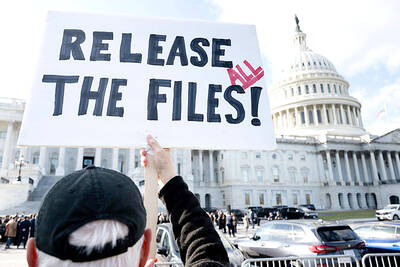Sitting on rubble, using his briefcase as a writing table, human rights researcher Yasser Abdel Ghafar interviewed residents of a house shelled by Israel, part of his assignment to compile detailed lists of killed and wounded during Israel’s 23-day war on Gaza’s Hamas rulers.
His group, the Palestinian Center for Human Rights (PCHR), released a final tally on Wednesday, saying 1,284 Gazans were killed and 4,336 wounded, the majority civilians. Yet Israel, insisting that Hamas is inflating civilian casualties, said it has the names of more than 700 Hamas militants killed in fighting.
The wrangling over the final toll, particularly the ratio of combatants and civilians, is part of the rival Israeli and Palestinian narratives of the Gaza war. Israel portrays it as a justified attempt to finally halt years of indiscriminate Hamas rocket attacks on southern Israel. The Palestinians say it was a brutal onslaught in which troops used disproportionate force in one of the world’s most densely populated areas. Some bombings and shellings of homes, even if targeting militants, killed entire families.

PHOTO: AP
Israeli Defense Minister Ehud Barak said Hamas fighters fired rockets from civilian areas and stored explosives in mosques and schools. Yet he acknowledged that troops “moved forward with fire” to prevent Israeli casualties and that “nobody had any illusions that civilians wouldn’t be harmed as well.”
The growing international outrage over Israel’s offensive has been fueled by the scenes of civilian suffering, including bodies of dead women and children in hospital morgues.
The PCHR said 894 of the dead were civilians, including 280 children and minors, age 17 and under, as well as 111 women. Of the remaining 390 dead, 167 were members of Hamas’ civil police, many of them killed on the job during Israel’s surprise attack on dozens of security compounds.
The civilians not only included innocent bystanders, but also Hamas members killed in non-combat situations, such as Said Siam and Nizar Rayan, two top Hamas leaders assassinated, along with their relatives, in massive bombings of homes, said Ibtissam Zakout, head of the PCHR’s research team.
The rest, or 223, were combatants, she said. That figure is higher than the 158 dead fighters acknowledged by Hamas, Islamic Jihad and other militant groups.
“Maybe they [the militants] were interested to show that they have fewer losses and casualties,” Zakout said.
Others, such as Gaza health ministry official Moawiya Hassanain, have raised the possibility that the militant groups buried some of their fighters in secret, without reporting their deaths.
Zakout said the PCHR count, including the distinction between militants and civilians, is based on cross-checking hospital records and interviews with survivors. The group is affiliated with Geneva-based International Commission of Jurists and has won two European human rights awards.
During the war, 13 Israelis were killed, including three civilians struck by rockets. The other 10 were soldiers.
Israel has not provided its own Palestinian death toll, though Barak said he believed dead militants outnumbered dead civilians.
“Many more than 700 Hamas men were killed, many more,” he told Israel’s Channel 10 TV.
“We know their names,” he said, while noting that civilians were hit as well.
However, Palestinian medics and human rights researchers say they’ve become well-versed in counting casualties during previous conflicts, including two uprisings against Israeli military occupation and internal Palestinian fighting.
A veteran is Hassanain, the health ministry official who has been recording dead and wounded since the start of the second Palestinian uprising in 2000.
Hassanain’s center of operations is a tiny room with furniture he said dates back to pre-1967 Egyptian rule of Gaza. Equipped with just a beeper, a fax, a landline, two mobile phones and a walkie talkie, Hassanain dispatches dozens of ambulances and records the medics’ first reports of dead and wounded on loose sheets of paper.
In between, he accompanies ambulances taking the most seriously wounded to Israel and Egypt.
Hassanain’s handwritten lists, including some stuffed in his jacket pocket, are eventually fed into a clunky old computer by an assistant and transferred to the information center of the health ministry.
The ministry, like most Gaza government agencies, is run by Hamas. Israeli warplanes targeted many Hamas ministries during the war, and the health ministry moved part of its operations to Gaza’s main Shifa Hospital after the start of the offensive.
The ministry’s computer center is fed by faxed reports sent by teams deployed at Gaza’s 20 hospitals and clinics, said statistics chief Samir Radi, who did part of his physician’s training at an Israeli hospital.
The health ministry’s final toll for 23 days of fighting is 1,324 dead and about 5,400 injured — or 40 more dead and about 1,000 more injured than the PCHR.
Radi said names are added to the death toll only after careful consideration, including identification by ID by relatives, particularly if bodies arrive in a dismembered state.
The physician claimed that only about 100 of the dead were combatants, saying he is relying on reports by the militant groups themselves.

A feud has broken out between the top leaders of the far-right Alternative for Germany (AfD) party on whether to maintain close ties with Russia. The AfD leader Alice Weidel this week slammed planned visits to Russia by some party lawmakers, while coleader Tino Chrupalla voiced a defense of Russian President Vladimir Putin. The unusual split comes at a time when mainstream politicians have accused the anti-immigration AfD of acting as stooges for the Kremlin and even spying for Russia. The row has also erupted in a year in which the AfD is flying high, often polling above the record 20 percent it

Ecuadorans are today to vote on whether to allow the return of foreign military bases and the drafting of a new constitution that could give the country’s president more power. Voters are to decide on the presence of foreign military bases, which have been banned on Ecuadoran soil since 2008. A “yes” vote would likely bring the return of the US military to the Manta air base on the Pacific coast — once a hub for US anti-drug operations. Other questions concern ending public funding for political parties, reducing the number of lawmakers and creating an elected body that would

The latest batch from convicted sex offender Jeffrey Epstein’s e-mails illustrates the extraordinary scope of his contacts with powerful people, ranging from a top Trump adviser to Britain’s ex-prince Andrew. The US House of Representatives is expected to vote this week on trying to force release of evidence gathered on Epstein by law enforcement over the years — including the identities of the men suspected of participating in his alleged sex trafficking ring. However, a slew of e-mails released this week have already opened new windows to the extent of Epstein’s network. These include multiple references to US President Donald

CHARGES: The former president, who maintains his innocence, was sentenced to 27 years and three months in prison for a failed coup bid, as well as an assassination plot Far-right former Brazilian president Jair Bolsonaro is running out of options to avoid prison, after judges on Friday rejected his appeal against a 27-year sentence for a botched coup bid. Bolsonaro lost the 2022 elections and was convicted in September for his efforts to prevent Brazlian President Luiz Inacio Lula da Silva from taking power after the polls. Prosecutors said the scheme — which included plans to assassinate Lula and a top Brazilian Supreme Court judge — failed only due to a lack of support from military top brass. A panel of Supreme Court judges weighing Bolsonaro’s appeal all voted to uphold